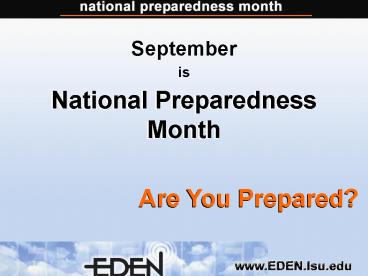National Preparedness Month Power Point Presentation - PowerPoint PPT Presentation
1 / 22
Title:
National Preparedness Month Power Point Presentation
Description:
NPM is a campaign held in September to encourage Americans to take steps to ... To file a complaint of discrimination write USDA, Director, Office of Civil ... – PowerPoint PPT presentation
Number of Views:135
Avg rating:3.0/5.0
Title: National Preparedness Month Power Point Presentation
1
September
is
National Preparedness Month
National Preparedness Month
2
Disasters in the United States
- Average Each Year
- Cost 52 billion (1 billion per week)
- Fatalities 480
Shell Pt., FL., 7/18/2005 -- Stuffed animals hung
out to dry following Hurricane Dennis. FEMA
photo/Andrea Booher
3
Costliest U.S. Disasters
1988 Drought 40 billion 10,000 deaths 1993
Midwest Floods 21 billion 48 deaths 2005
Hurricanes Katrina Rita 85 billion 1,843
deaths
4
Terrorism Raises the Toll
September 11, 2001 40 billion 2,751
deaths Major disaster concerns are no longer just
weather-related.
5
Are You Prepared?
In order for a community to be prepared for a
disaster, everyone needs to take the necessary
steps to become disaster-ready. - Statement by
DHS and American Red Cross
6
Cooperative Extension Service
Stands as a valuable resource in disaster
education. Value was proven in 1993 Midwest
Floods - The result was EDEN
7
EDENs Available Resources
- Through a national Web site and an email
listserv, EDEN delegates in each state share
information on - Natural disasters
- Man-made disasters
- Terrorism-related disasters
8
National Preparedness Month
- What is it? - NPM is a campaign held in September
to encourage Americans to take steps to prepare
for disasters in their - Homes
- Businesses
- Schools
9
National Preparedness Month
- Sponsored by
- U.S. Department of Homeland Security
- Joined by 100 partners nationwide
- Through EDEN, Extension is a partner
10
National Preparedness Month
- Areas of Focus
- Week 1 Ready Kids
- Week 2 Ready Business
- Week 3 Listo
- Week 4 Ready America
11
EDENs Role in NPM
- Through your own community
- To provide educational materials on disaster
preparedness. - To provide easy access to valuable online
resources and disaster organizations.
12
Why Do You Need to Prepare?
- Disasters are unpredictable
- Disasters happen in every community
- Your familys well-being is important
13
How Can You Prepare?
- Prepare a disaster supplies kit that will
sustain you for three or more days. - Know your local emergency management system.
- Be aware of the types of disasters that are
likely to effect you. - Have a NOAA weather radio on hand.
14
How Can You Prepare?
- Disaster supplies kit
- Three-day supply of non-perishable food
- Three-day supply of water
- Portable, battery-powered radio
- Flashlight
- Cash and coins
15
How Can You Prepare?
- Family Communications Plan
- Your family may not be together when disaster
strikes, so plan how you will contact one another
and review what you will do in different
situations. - Download your own plan at www.ready.gov/america/f
amily_plan.html
16
How Can You Prepare?
- Understanding your community
- Find out what kinds of disasters are most likely
to occur in your area. - Inquire about emergency plans at places where
your family spends time work, daycare, and
school.
17
How Can You Prepare?
- Protecting your business
- An estimated 25 do not reopen following a major
disaster - Ready Business is a program offered by DHS
EDEN to help prepare businesses with plans.
Access materials at www.EDEN.lsu.edu/LearningOps
18
Volunteering
- Helping a community be prepared
- Join Citizen Corps
- Contact or visit the local
- American Red Cross
- Emergency Management Agency
- County Extension Service.
19
EDEN has the Information
- www.EDEN.lsu.edu
- Search for materials on all disasters
- Access research-based disaster information from
land grant universities - Link to various federal disaster agencies
20
The September Campaign
- EDENs Web page for NPM (www.EDEN.lsu.edu/npm)
- Answers a multitude of questions on disaster
preparedness. - Provides necessary resources to help you become
disaster prepared.
21
Disasters are Like Pop Quizzes
Wouldnt you prefer to be prepared?
22
Thank You!
Your name Contact information
The EDEN National Preparedness Month materials
were developed with funding from the Cooperative
State Research, Education and Extension Service,
U.S. Department of Agriculture under CSREES/USDA
Agreement No. 2005-37620-15609 . Any opinions or
recommendations expressed in this publication are
those of the authors and do not necessarily
reflect the view of the U.S. Department of
Agriculture. The U.S. Department of Agriculture
(USDA) prohibits discrimination in all its
programs and activities on the basis of race,
color, national origin, sex, religion, age,
disability, political beliefs, sexual
orientation, and marital or family status. (Not
all prohibited bases apply to all programs.)
Persons with disabilities who require alternative
means for communication of program information
(Braille, large print, audiotape, etc.) should
contact USDAs TARGET Center at (202) 720-2600
(voice and TDD). To file a complaint of
discrimination write USDA, Director, Office of
Civil Rights, Room 326-W, Whitten Building, 14th
and Independence Avenue, SW, Washington, DC
20250-9410 or call (202) 720-5964 (voice or TDD).
USDA is an equal opportunity provider and
employer.






























